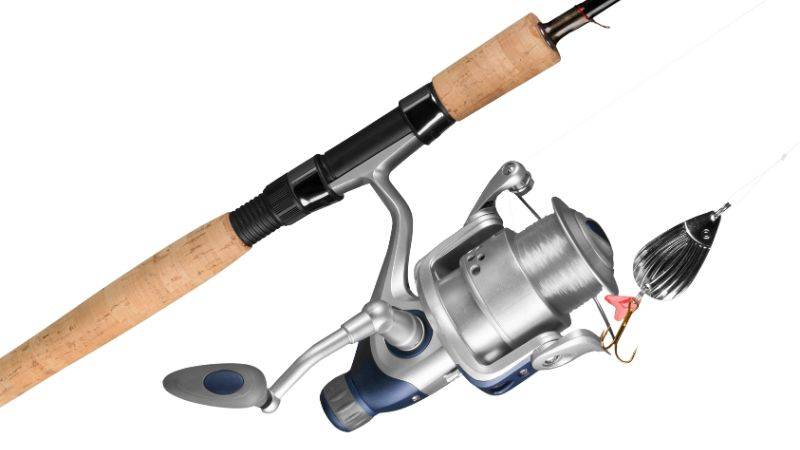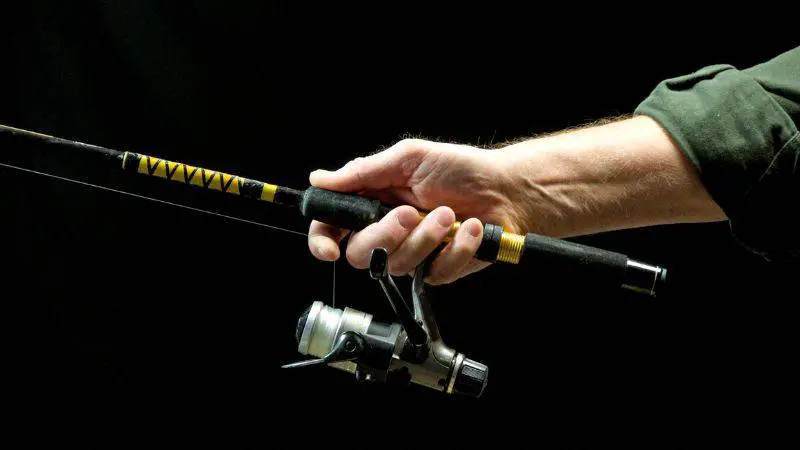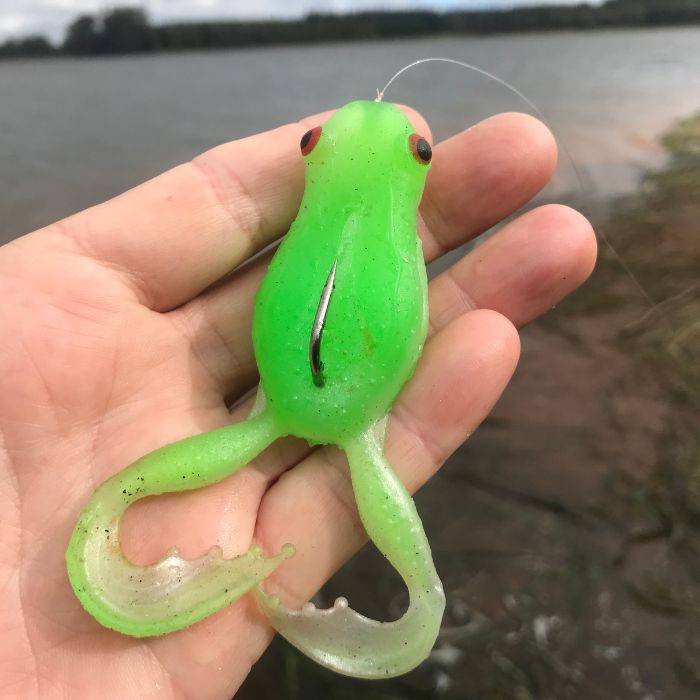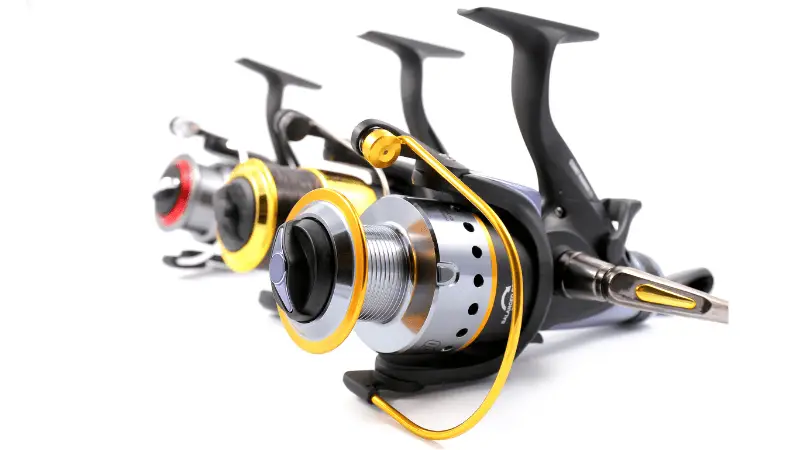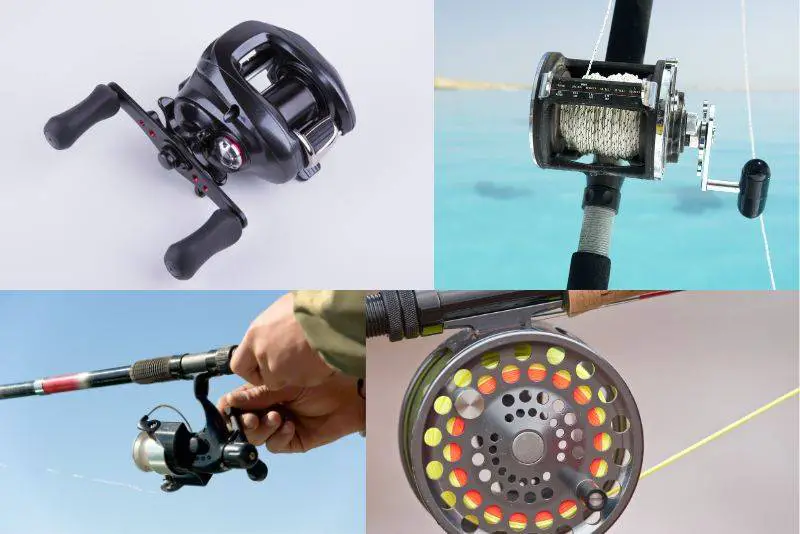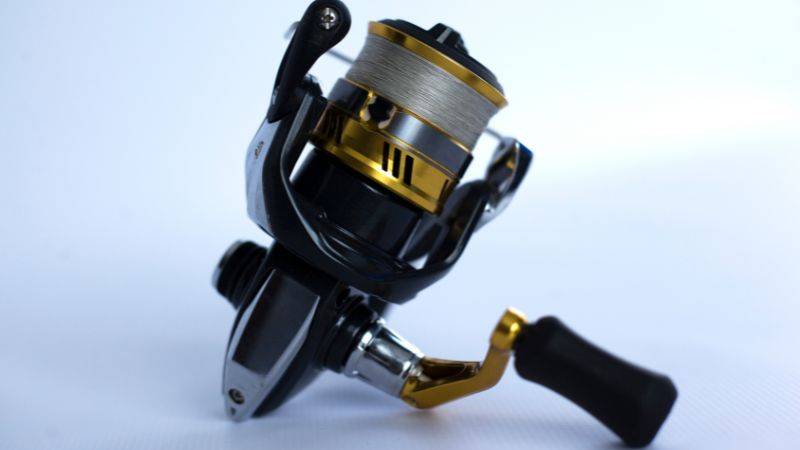
In this article we will discover how to choose a spinning reel.
We’ll explore the steps to selecting the perfect spinning reel for your needs. From discussing different sizes to understanding what features matter, we aim to make your reel and fishing rod work in harmony.
A spinning reel is a vital part of your fishing rod that allows you to cast your line far and wide and reel in your catch.
What are Spinning Reels?
Spinning reels are a type of fishing reel that sits underneath the fishing rod.
They have a fixed spool, and you cast the line out by flipping open a wire bail. When you turn the handle, the bail wraps the line back onto the spool.
Spinning reels are great for beginners because they’re easy to use and don’t tangle the line much.
Tip: Look for a spinning reel with a comfortable handle. It makes reeling in fish easier on your hands.
Spinning reels are popular among fishermen who chase all kinds of fish, from tiny sunfish in ponds to big bass in lakes. They work well with light lures, soft plastics and baits, which is why so many people like them.
See also – Spinning Reel Buyers Guide
Spinning Reel Sizes
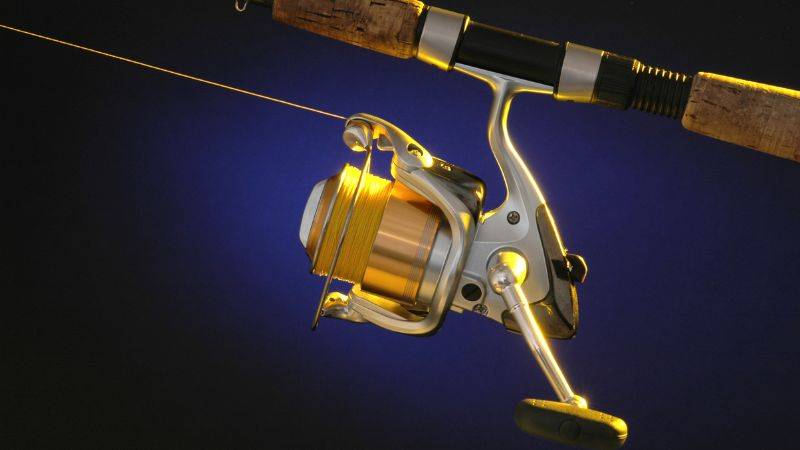
Numbers & Applications
The size of a spinning reel is marked by numbers like 1000, 2500, 3000, and up. The bigger the number, the bigger the reel.
A 1000-size reel is lightweight and good for small fish like panfish and smaller trout.
When you move up to a 2500 or 3000, you’re looking at reels suitable for medium-sized fish like bass. Big reels, like 4000 and above, are for big fish and heavy lines.
Tip: A smaller reel is easier to handle for long hours. It’s perfect for kids or when you’re fishing for fun.
Choosing the Right Reel Size
Picking the right reel size depends on what fish you’re after and where you’re fishing. If you’re going to fish in a small stream, a smaller reel (1000-2000) works great.
For general freshwater fishing, like in a lake, a 2500 to 3500 reel is a good choice. And if you’re aiming for big fish in the ocean or large rivers, consider a 4000 size or larger.
Tip: Match your reel size to your rod size for the best balance and comfort.
Whether you’re a beginner or an experienced angler, the right size spinning reel can make your fishing trips more enjoyable and successful.
Reel Gear Ratio
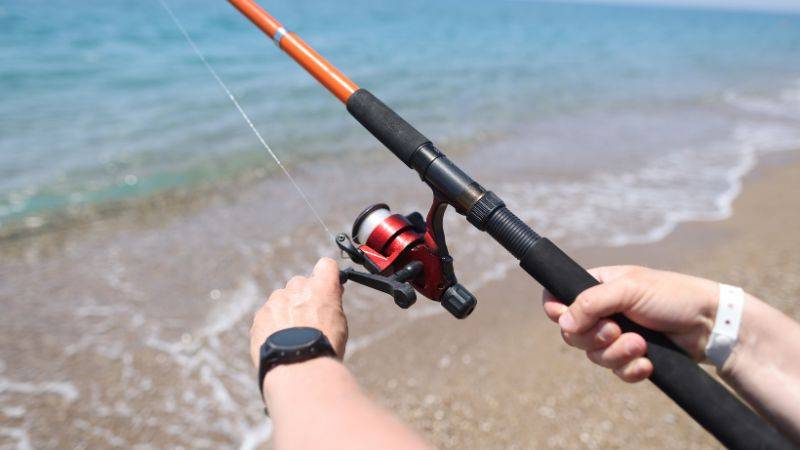
The gear ratio tells you how many times the spool spins each time you turn the handle.
A 5:1 gear ratio means the spool turns 5 times with one handle turn. Lower ratios like 4:1 are good for heavy lures and big fish because they have more power.
Higher ratios, like 6:1 or 7:1, let you reel in the fishing line faster, which is great for quick lures or when you need to bring in the line quickly.
Tip: Use a high gear ratio reel for lures that need to be moved quickly across the water.
Spinning Reel Drag Systems
The drag system on a spinning reel lets you set how much resistance a fish feels when it pulls on the line.
A good drag system will let the line out smoothly when a big fish pulls hard, which helps prevent the line from breaking.
There are two main types: front drag and rear drag. Front drag systems are usually more durable and perform better with big fish.
Rear drag systems are easier to adjust during a fight with a fish.
Tip: Check the drag before buying by pulling on the line. It should come out smoothly, without jerking.
First-hand Experience: Once, while fishing with a reel that had a smooth drag system, I hooked a large bass that fought extremely hard. Thanks to a good drag, I could manage the fish’s runs without the line breaking, eventually reeling it in successfully. It showed me how crucial a good drag system is when battling larger fish.
Choosing the right spinning reel involves understanding these basics and considering what kind of fishing you’ll be doing.
Spinning Reels & Ball Bearings
Ball bearings in spinning reels make them smooth to use. Think of ball bearings as tiny balls that help parts inside the reel move without sticking.
More ball bearings mean a smoother reel, which is good when you’re reeling in a fish or casting your line.
Tip: The quality of ball bearings is as important as the amount for smooth winding.
Some reels have special ball bearings called “shielded,” “double shielded,” or “sealed.” These are protected against dirt and water, making your reel last longer.
Comparison: A reel with 3 sealed ball bearings might be better than one with 6 regular bearings if you fish in dirty or salty water because it stays smooth longer.
Spinning Reel Components
Drag
The drag lets you control how hard a fish can pull on the line without breaking it. A good drag is smooth and easy to adjust.
Some reels have the drag knob on the front (front drag) and others have it at the back (rear drag).
Spool Design
The spool holds your fishing line. Some spools are designed to help cast farther by reducing how much the line rubs against the edge. “Long cast” spools are flatter and can help you throw your bait out where the big fish are.
Handle
The handle is what you turn to reel in your line. Most handles can be switched from one side to the other, so it doesn’t matter if you’re right or left-handed. Handles with a comfortable grip are nice for fishing all day without getting sore hands.
See also – How To Change A Fishing Reel Handle
Line Roller
The line roller guides your line back onto the spool evenly when you reel in. A smooth roller helps keep your line from getting twisted.
Bail Arm
The bail arm opens and closes the path of the line on the spool. When casting, you flip it open to let the line fly off. Make sure it snaps back easily for a trouble-free day of fishing.
Seals
Seals protect the inside of your reel from water and dirt. If you fish in harsh conditions, like saltwater or muddy rivers, look for a reel with good sealing.
What Factors Go into Determining the Right Spinning Reel
Matching Your Reel with a Rod
The best reel won’t do much good if it doesn’t fit your rod. Light reels go with light rods, and heavy reels need sturdy rods. The balance should feel right in your hand, not too top-heavy or too light.
First-hand Experience: I once matched a heavy reel with a light rod for a fishing trip. It felt awkward and made casting hard. When I switched to a balanced setup, my casting improved, and fishing felt easier.
Spinning Reel Materials
Reels are made from different materials like aluminum, graphite, or a mix of both. Aluminum is tough and good for fighting big fish. Graphite is lighter, which is nice for fishing all day without getting tired.
Comparison: An aluminum reel might be better for saltwater fishing because it’s strong and resists corrosion. Graphite is great for freshwater or if you want something lighter.
Styles of Fishing
The type of fishing you do affects what reel you should choose. For casting lures or baits far, look for a reel with a good “long cast” spool.
If you’re want to throw around top water lures, a reel with a high gear ratio lets you reel in quickly.
Tip: Think about where you fish most. A versatile reel is great for starting, but specialized reels can make a big difference in how much you enjoy your favorite fishing style.
What Are The Types Of Fishing Reels?
Choosing the right spinning reel involves looking at many parts and thinking about where and how you fish. Whether you’re after a relaxing day by the water or chasing the catch of a lifetime, the right reel makes all the difference.
FAQs – Choosing A Spinning Reel
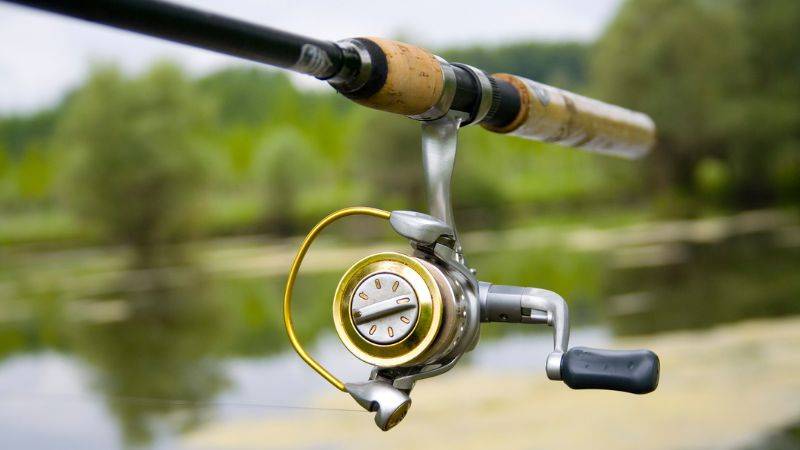
How do you know what size spinning reel to buy?
To choose the right size spinning reel, consider the type of fish you’re targeting and the fishing line weight you plan to use.
Smaller reels (1000-2500 sizes) are great for light lines and small to medium fish, while larger reels (3000-5000 sizes) are better for heavier lines and larger fish.
Consider where you’ll fish—freshwater or saltwater—and the size of your fishing rod for a balanced setup.
How do I find a good spinning reel?
Look for a spinning reel with a solid build quality, smooth drag system, and sufficient ball bearings for smooth operation.
Consider the gear ratio for your fishing style, the reel’s material (aluminum or graphite) for durability, and the size that matches your fishing needs. Reading reviews and comparing brands can also help you find a good reel.
What is a 1000 size spinning reel good for?
A 1000 size spinning reel is great for ultralight fishing, targeting small fish like panfish, trout, and small bass. It works well with light lines and lures, making it ideal for finesse fishing in streams, ponds, and small lakes.
What is a 2000 size spinning reel good for?
A 2000 size spinning reel is versatile for light to medium fishing situations. It’s suitable for catching small to medium-sized fish, such as bass, trout, and crappies, with slightly heavier lines than a 1000 size reel. It’s good for both freshwater and light inshore saltwater fishing.
Is Penn better than Shimano?
Penn and Shimano are both highly respected brands in the fishing industry, and each has its strengths.
Penn is known for its durability and strength, making its reels great for saltwater and heavy-duty fishing.
Shimano is renowned for innovation, technology, and smoothness.
The choice between them often comes down to personal preference and specific fishing needs.
What is a size 4000 reel good for?
A size 4000 reel is good for medium to heavy freshwater fishing and light to medium saltwater fishing. It can handle larger fish, such as larger bass, northern pike, and smaller saltwater species. It’s versatile for various fishing techniques, including casting larger lures and using heavier lines.
Is Daiwa a Japanese company?
Yes, Daiwa is a Japanese company. It was founded in 1958 and is known for producing high-quality fishing gear, including reels, rods, and fishing accessories. Daiwa is renowned for its innovation and technology in the fishing industry.
What is the hardest fishing reel to use?
Baitcasting reels are often considered the hardest fishing reels to use, especially for beginners. They require precise thumb control to manage the spool’s speed during a cast, which can be challenging to master without causing bird’s nests or tangles.
What is the easiest fishing reel to use?
Spincast reels are the easiest fishing reels to use, making them ideal for beginners and children. They have a push-button design that makes casting straightforward and minimizes the risk of tangles and bird’s nests.
What is a good all-round fishing reel?
A good all-round fishing reel is typically a spinning reel in the 2500 to 3000 size range. These reels are versatile enough to handle a wide variety of fishing situations, from freshwater to light saltwater applications, and can target a range of fish sizes.
What Okuma reel is good value?
The Okuma Ceymar spinning reel is often praised for its good value. It offers a great combination of durability, smoothness, and performance at an affordable price point, making it a popular choice among both casual and serious anglers.
What is the most common fishing reel?
The most common fishing reel is the spinning reel. Its ease of use, versatility, and suitability for a wide range of fishing conditions make it a favorite among anglers worldwide, from beginners to experienced fishermen.
Conclusion
Equipped with the knowledge to make an informed decision for your next fishing trip, we hope you have enjoyed our guide on “How To Choose a Spinning Reel.”
We have dived into various aspects, from the importance of reel size and compatibility with your rod, to considering the reel’s material and the type of fishing its best suited for.
The core of a great fishing experience lies not in having just any reel but in finding the one that aligns with your fishing preferences. Take into account the species you’re targeting, the environments you’ll be exploring, and the overall feel in your hands.
Armed with the right spinning reel, you will be ready to cast your line into new waters and reel in those catches.

